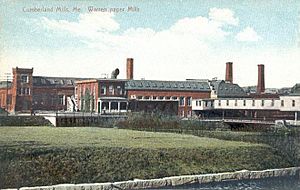S. D. Warren Paper Mill facts for kids
Quick facts for kids |
|
|
Cumberland Mills Historic District
|
|
 |
|
| Location | Both sides of the Presumpscot River between railroad tracks and Warren Avenue, Westbrook, Maine |
|---|---|
| Area | 110 acres (45 ha) |
| Architect | John Calvin Stevens & Francis H. Fassett |
| Architectural style | Queen Anne, Shingle-style |
| NRHP reference No. | 74000316 |
| Added to NRHP | May 2, 1974 |
The S.D. Warren Paper Mill is a large paper factory located on the Presumpscot River in Westbrook, Maine. Today, it is owned by SAPPI Limited, a paper company from South Africa. This mill is one of the biggest employers in Westbrook. The factory buildings and the homes where workers and managers lived in the 1800s are part of the Cumberland Mills Historic District. This district was added to the National Register of Historic Places in 1974 because of its important history.
Contents
The S.D. Warren Paper Mill: A Big Story
The Warren paper mill is a huge industrial area that stretches across the Presumpscot River in Westbrook. A paper mill first started here in the 1730s. At that time, this area was mostly countryside with very few people.
How the Mill Started
In 1854, Samuel Dennis Warren, known as S.D. Warren, bought the small paper mill for $28,000. It was located in what would soon become the town of Westbrook. The mill was named Grant, Warren and Company. Back then, the mill only had two paper machines. It could make about 3,000 pounds of paper every day. Nine years later, in 1863, another machine was added. This helped the mill make much more paper, reaching 11,000 pounds per day.
Making Paper: A New Idea
In 1854, paper was mostly made by breaking down old rags into a soft pulp. But in 1867, after the mill changed its name to S.D. Warren Paper Mill Company, Warren had a new idea. He decided to mix wood fibers with rag fibers to make paper. This was a big deal! It was the first mill in the United States to do this. This new method helped the mill grow even more. By 1880, the mill was producing an amazing 35,000 pounds of paper every day, becoming the largest paper mill in the world.
Growing Bigger and Changing Hands
S.D. Warren passed away in 1888. His son, also named Samuel Dennis Warren, took over the business. He managed the mill until he died in 1910. The mill kept growing throughout the 1900s. It employed nearly 3,000 people from Westbrook, which was a huge number for the town.
In 1967, Scott Paper Company bought S.D. Warren. Scott Paper Company ran the mill as a separate part of their business until 1994. Then, they sold the mill. In 1995, SAPPI Limited, a paper company from South Africa, bought the mill for $300 million. After this, much of the work was moved to South Africa. Today, the mill employs about 300 people. Even with fewer employees, it is still an important part of Westbrook.
A Historic Place
The mill property and many buildings around it were recognized as historic in 1974. They were added to the National Register of Historic Places. This listing included the mill itself. It also included a row of unique worker homes on Brown Street. These homes were designed by famous architects John Calvin Stevens and Andrew Jackson Downing. Also included was the beautiful Queen Anne Victorian home of Warren's son John. This house is located across Cumberland Street from the mill.
How Materials Moved: Rail Facilities
The Cumberland Mills paper mill needed a way to get materials in and out. It was served by two different railroads. At first, horse-drawn wagons moved materials between the mill and the train tracks. In 1874, the mill started using small, 2 ft (610 mm) narrow gauge rails for these wagons.
Later, in 1895, Steam locomotives took over from the horses. These small trains helped move heavy loads. They brought in pulpwood, which is wood used to make paper. They also transported coal to power the mill's boilers. After 1949, new conveyor systems were built. These systems could move materials more easily. Because of this, the narrow gauge trains were no longer needed.




